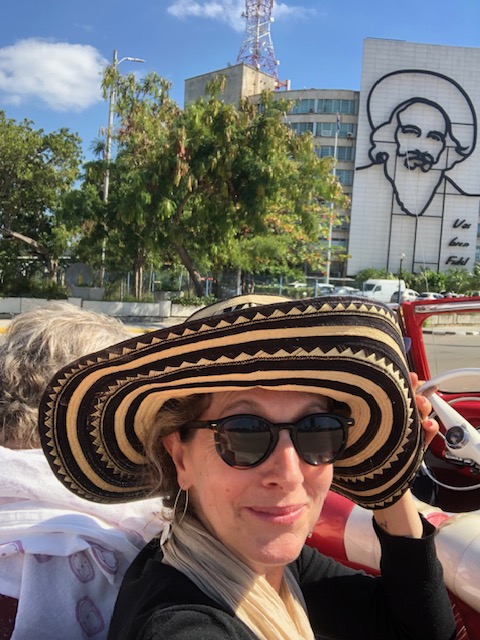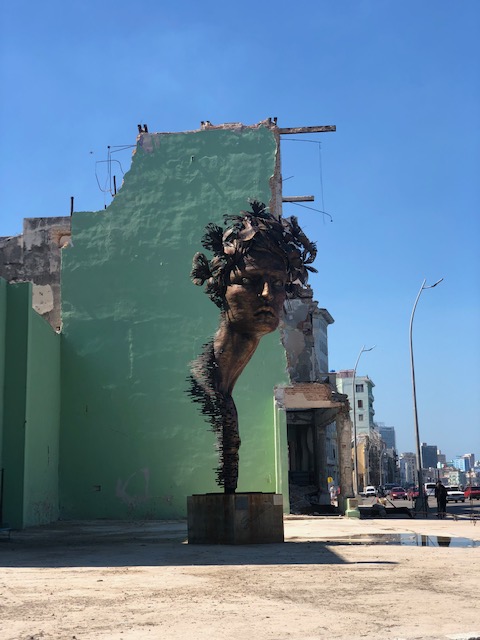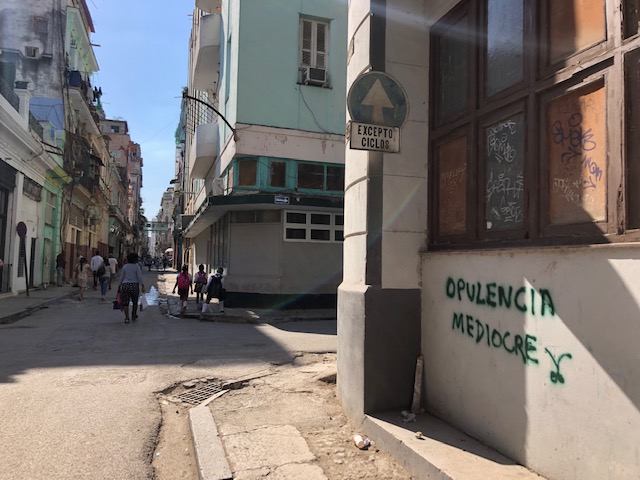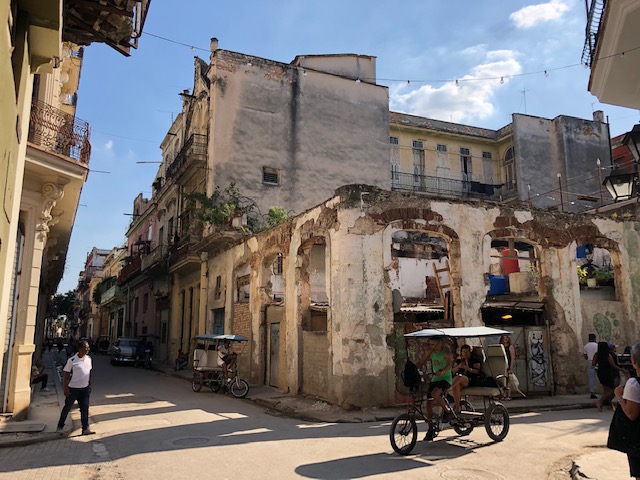Just make sure you do it legally and in a way that supports the Cuban people.

There were a lot of questions and not a small amount of surprise that I – an American! – was going to Cuba. Is that even legal? But how?, my friends asked. So I thought I’d outline how and why people should most certainly go visit the island of Cuba.
First of all, Cuba is just beautiful! The people are generally gorgeous and incredibly kind. Despite some longstanding hardships, most recently due to COVID and the lack of international travel, they remain resilient and open, helpful and kind.
We were in Cuba for a wedding so our stay was quite short, but full of celebration. After the ceremony, we were able to tour some of the historic sites and get in some fun dance classes. We also spent a day at a popular beach spot. Our trip required a lot of planning and a suspension of things that we take for granted, like easy to access WIFI and fresh food. In fact, it’s one place where my access – to food, electronics, clothing and or just plain Stuff – is in high relief. We in the US have so much. So I often leave (it’s my fourth time) with a bit of a heavy heart, hoping that the lives of Cubans will be easier soon. I also hope that our support and spending has made even a small difference in the lives of the people we met.

This car stalled in the middle of the road. 



Getting a tour of Havana.
So how does one plan a trip to Cuba? First, a bit about the regulations. The main law that prohibits Americans from traveling to Cuba is the Assets Control Regulations, implemented in July of 1963, and it falls under the Trading with the Enemy Act. This regulation prohibits Americans from visiting Cuba as a tourist.
However, the regulations do allow for legal visits that fall under 12 specific categories, including Family visits, Journalism, cultural exchange programs and Support for the Cuban People, which is the category under which I went. This latter category is useful as it can be broadly applied and includes activities like taking cooking classes, visiting historical sites and museums, or taking some awesome salsa classes!! Basically, the US Embargo prohibits Americans from spending money in government-run institutions and hotels, so you must take special care to make sure your dollar goes to local people and local businesses. You can do this by staying in casa particulares, eating in local restaurants (called paladares), and supporting private transport companies and individuals. This is increasingly easy as individuals are starting small businesses throughout the island. (Sorry, but many of those fabulous old cars are government owned so if your dream is to ride in one, you have to do a bit of digging to make sure you have a private owner.)

Money for lunch.

Cost
I’ll say right here that Cuba is not an inexpensive destination. The total for flights, accommodations, in-country transport and food can get really pricey, so don’t think of Cuba as a budget destination. Still, the experience is quite eye-opening and your dollar (or even better, your Euro) is helping a struggling economy.
Once you’ve decided which category you will identify to visit Cuba, you can get a plane ticket. Some airlines don’t show Havana as a location, so don’t be surprised. Skyscanner generally will suggest some flights. Be forewarned that they can be quite expensive. I took an American Airlines flight through Miami but I may as well have been flying to Europe for the time and expense. Next time I’ll go through Mexico City.
You can find accommodations through AirB&B. Just make sure these are casa particulares and not government-run hotels. Try to find a place that offers breakfast and (preferably Free) WIFI. This doesn’t mean great, all-day connection, by the way. We had connectivity for a few hours a day and even then, it was so slow, it was mainly good for some quick WhatsApp check-ins with Aiden and friends. You can also buy WIFI time at some hotels and restaurants. For now, I would never recommend Cuba for remote work. This could change soon.
There is usually an additional charge for breakfast as well, unless otherwise noted. But it’s good to have the option for food at your residence.
Other requirements
You need an up-to-date passport with more than 6 months remaining. You also need additional travel health insurance to cover any unexpected medical expense you might incur, and should include evacuation insurance. I bought mine through Allianz, but you can also try Insubuy.
You will need a visa, which you can get here in advance: https://opapeleo.com/ This ran me $80 but can get upwards of $150 depending on where you buy it (for example, through an airline).
You will need a customs form that should be filled out and preferably printed out in advance. You can do this within three days of your travel time: https://dviajeros.mitrans.gob.cu/inicio
Money
The official Cuban currency is the CUP Cuban Peso and our exchange was roughly $160 CUP/$1USD. If anyone tries to give you CUC, they’re scamming you as CUC are no longer being used. You also can’t get money in advance, so plan on changing the majority of your money once you’ve left the airport. Do be aware that your credit card will not work in Cuba. However, and unlike prior visits, our dollars and Euros were welcome.
Activities
We took our salsa classes at the Casa del Son in old Havana, and they were fabulous! $15 for an hour of private class with, for the most part, stellar dance teachers. We didn’t have the chance to go out many nights but there are lots of options there, too.
One of the most wonderful weekend places to visit is an old warehouse turned performance art space called the Fabrica de Arte Cubano. This place is crammed with gorgeous people, some really great art, and a variety of musical options. Time Magazine in 2019 called it one of the World’s 100 Greatest Places. Very cool. Very fun. A must see if you’re visiting Havana.

A few other tips.
TIP! Cubans expect tips, and 10-20% is expected. In some restaurants 10% will automatically be added.
In old Havana beware of where you’re walking. Try not to walk under crumbling balconies as falling concrete has killed passersby. Of course be aware of street traffic too. And don’t expect cars to stop for you if you’re meandering across the street. They won’t.
Otherwise, Cuba is quite safe. We were told by many that women, even walking alone late at night, had nothing to fear. This doesn’t mean you should wander drunk or not pay attention. Keep your wits about you at all times. But Cuba is generally much safer for tourists than most American cities. We also had additional security at our hotels for our belongings.
Taxis are expensive. As a tourist you’ll certainly be quoted a higher price. It is expected that you haggle a bit but try to remember that the price of gas is high and fixing a car if it breaks down requires importing parts, which often requires having a contact out of country willing to help you. In other words, it’s really difficult.
Also, please don’t go empty handed. Most Cubans need everything. They have limited food, medicine and a bazillion other things we completely take for granted in more developed places. Soap, perfume, toothbrushes, aspirin and antibiotics. We also brought big jars of peanut butter and Nutella, pens, detergent and even family packs of toilet paper! Sure, some of this can be accessed some of the time, but if it is available, it’s generally very expensive. So bring some useful items to give.
If you’re interested in joining a group tour to take some dance classes later this year, definitely drop me a note. I didn’t quite get my dance fill so I’m already wondering when I might head back.





